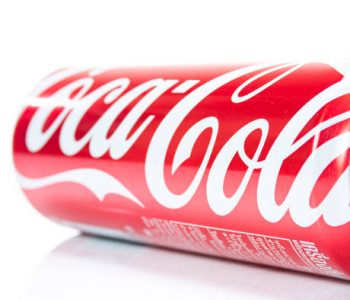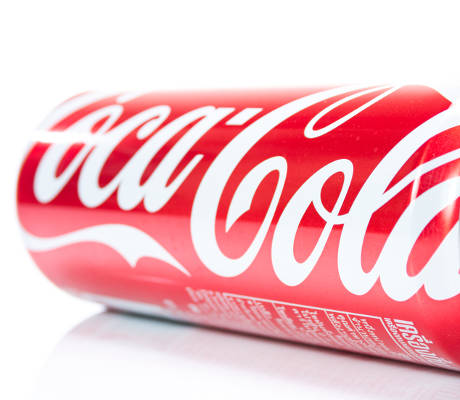Why Coca-Cola Co’s Decline Is Great for Dividend Investors: A Yield of 3.5%

No business is immune to disruption—not even one that has sold syrupy soft drinks since 1892. Often the bedrock of conservative dividend portfolios, The Coca-Cola Co (NYSE:KO) stock is down about 15% from its 52-week highs amid slumping revenue and mounting pressure from health advocates, who blame sugary drinks for the global obesity epidemic.
The latest dent came late last week when yet another earnings disappointment sent KO stock down more than three percent, just begging the dividend bargain hunter in me to take a closer look.
As I always tell our Income Investors readers: there is simply no easier way to build wealth than to consistently buy blue-chip dividend stocks when they go on sale. Now, you just can’t blindly do this. You need to make sure that company fundamentals remain firm and that the decline is simply a short-term headache, as opposed to long-term trauma.
So what’s the story in Coke’s case? Let’s take a closer look at the quarter and find out.
Unsweetened Q4
Coke’s Q4 earnings per share (EPS) clocked in at $0.37, largely in line with analyst estimates, but revenue continued to decline, down six percent year-over-year to $9.4 billion.
Weighing on the numbers was a one-percent decline in case volume, as well as continued foreign exchange headwinds. Additionally, the company’s massive and costly bottling overhaul continues to drag on. Coke has been shedding its capital-intensive, low-margin bottling assets to help deal with the drop in demand for carbonated drinks, but needless to say, investors are becoming impatient with how long the process is taking. (Source: “The Coca-Cola Company Reports Fourth Quarter And Full Year 2016 Results,” The Coca-Cola Co, February 9, 2017.)
On the positive side, volume managed to edge up one percent in North America. Moreover, organic revenue (which excludes the impact of acquisitions and foreign exchange) actually increased six percent year-over-year on a strong price/mix, indicating that while volume remains relatively weak, the company’s pricing power is still highly impressive.
Still, Coke expects full-year 2017 organic revenue to increase just three percent and adjusted EPS to fall between one and four percent over 2016.
In other words, management just sees more of the same sluggish story: declining revenue amid weak volume, ongoing bottling divestitures, and tough currency headwinds.
“[W]hile we are pleased with our underlying trajectory, our comparable EPS has not grown over last several years,” said Coca-Cola’s President and incoming Chief Executive Officer James Quincey. “So, importantly, we are intensifying our focus on delivering comparable EPS growth each year. We won’t sacrifice the long-term health of the business, but we need to better balance investing to grow the business with delivering earnings growth in an environment like this.” (Source: “The Coca-Cola Company’s (KO) CEO Muhtar Kent on Q4 2016 Results – Earnings Call Transcript,” Seeking Alpha, February 10, 2017.)
Thirst-Quenching Dividends
Of course, as members of the Income Investors community, our primary concern is whether or not Coke’s fundamentals are able to fuel a healthy and growing dividend going forward.
Well, that’s a tad tricky.
Now, to be sure, you’d be hard-pressed to find companies that can even come close to matching Coke’s dividend growth history; the company has paid a dividend since 1920 and has increased it in each of the last 54 years. The problem, however, is that the combination of a rising dividend and declining EPS of late has Coke’s payout ratio currently sitting at a relatively high 85%. So despite the company’s nearly unmatched track record of dividend growth, some income-oriented investors are understandably growing a bit nervous.
Me? Not so much. Because while a super-high payout ratio is usually worrisome with much younger companies, Coke’s highly stable cash flows can more than support it—and cash is what matters.
Even with all the troubles in 2016, the company managed to generate operating cash flow of $8.8 billion, $8.3 billion of which was returned to shareholders through net share repurchases and increased dividends. If all management ever did was slow down the pace of dividend increases, Coke should have no trouble maintaining its dividend growth streak while still being able to buy back stock opportunistically.
In other words, Coke’s lack of growth and high payout ratio make it somewhat akin to a boring old utility investment right now. But with such healthy cash flow and depressed stock price, it might also provide decent upside if growth ever returns.
The Bottom Line on KO Stock
KO stock is drifting to a point where I’d seriously consider jumping in.
Despite currency headaches and the ongoing attack on sugar, Coke easily remains the largest beverage company in the world, with the brand recognition, pricing power, and massive scale to keep generating a stable level of cash flow for dividend investors.
Now, of course, Coke will eventually need to find new sources of growth in order to fuel more inspired dividend increases. Given management’s flat outlook for 2017, that won’t be happening anytime soon. However, it’s tough to believe that management’s efforts to lower the calorie content in its portfolio—such as stressing smaller pack sizes, offering more sugar-free options, and reformulating certain products—won’t be a boon to the company’s long-term trajectory.
Moreover, Coca-Cola’s bottling overhaul in the U.S. will be completed by 2017, while refranchising in Asia continues to progress nicely. So while the process has been frustratingly lengthy for investors, the divestitures should provide a much-needed margin headwind over the next few years.
So basically, we’ll just have to keep waiting patiently for KO’s earnings growth to return, which I fully expect it will. But what’s the best part? With KO stock now flirting with the sub-$40.00 level and sporting a juicy 3.5% dividend yield, we can just sit back, wait, and get paid comfortably until it does.











